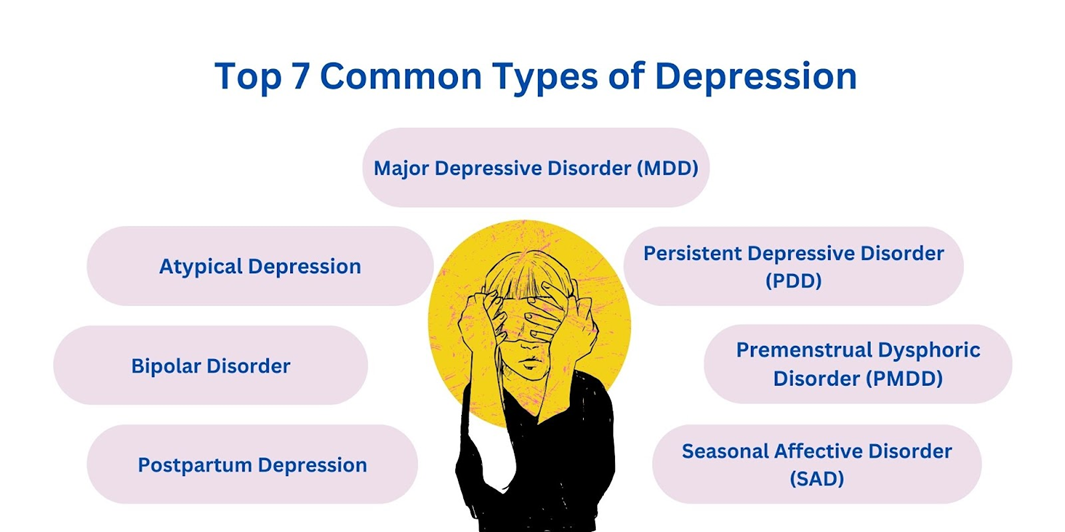
Top 7 Common Types of Depression

We all feel sad, moody, or low sometimes, it’s a normal part of life. If these feelings persist for over 2 weeks, it may indicate depression, a serious condition impacting physical and mental health. India faces a significant mental health crisis, with an estimated 56 million people suffering from depression and 38 million from anxiety disorders, according to a WHO report.
Understanding the different types of depression, their stages, and how to seek help can make a big difference. Let's dive into the top seven types of depression, with a special focus on mental health services in India. Let’s explore the different types of depression so we can understand them better and help those who might be feeling this way.
- Major Depressive Disorder (MDD)
- Lasts at least two weeks
- Changes in sleep and appetite
- Persistent Depressive Disorder (PDD)
- Lasts for at least two years
- Less severe than MDD but longer-lasting
- Bipolar Disorder
- Extreme mood swings
- Highs (mania) and lows (depression)
- Can be very confusing and tiring
- Seasonal Affective Disorder (SAD)
- Usually in winter
- Improves with more sunlight and warmth
- Postpartum Depression
- More intense than 'baby blues'
- Affects a mom's ability to care for herself and her baby
- Premenstrual Dysphoric Disorder (PMDD)
- Severe mood swings before menstruation
- More intense than regular PMS
- Causes significant distress and difficulty
- Atypical Depression
- Increased appetite and sleepiness
- Sensitive to rejection
Imagine feeling super sad, tired, and not wanting to do anything you usually love for weeks. This is what Major Depressive Disorder feels like. People with MDD might lose interest in their favorite activities, have trouble sleeping, and feel really hopeless.
Stage of Depression: Persistent Sadness
This one is like a shadow that sticks around for a long time. It can last for years even if it’s not as strong as MDD. People with PDD might not feel extremely sad all the time but have a low mood most days.
Stage of Depression: Chronic Low Mood
Think of Bipolar Disorder as a rollercoaster ride. People with this disorder experience extreme highs (mania) and lows (depression). During the highs, they might feel super energetic and happy, and during the lows, they might feel very sad and tired.
Stage of Depression: Depressive Episodes
Ever noticed how some people feel down during the winter when it’s cold and dark outside? This is what Seasonal Affective Disorder is like. It happens during certain seasons, usually winter, and goes away when the days get longer and sunnier.
Stage of Depression: Seasonal Changes
This type of depression happens to some moms after they have a baby. It’s not just the 'baby blues,' which go away after a few days. Postpartum Depression can last for months and make it hard for new moms to take care of themselves and their babies.
Stage of Depression: After Childbirth
You might know that girls and women have a monthly cycle called menstruation. PMDD is a severe form of premenstrual syndrome (PMS) that happens before their period. It can cause intense mood swings, irritability, and depression.
Stage of Depression: Menstrual Cycle
This type of depression can be tricky because it has some different symptoms than other types. People with Atypical Depression might feel happy when something good happens, but they also experience increased appetite, sleepiness, and sensitivity to rejection.
Stage of Depression: Mood Reactivity
STAGES OF DEPRESSION: AN INTERACTIVE GUIDE
Depression can be viewed in stages, from mild to severe:
Mild Depression:
Symptoms are present but do not significantly impact daily functioning. Ever had a 'blah' day that just won’t go away?
Moderate Depression:
Symptoms become more pronounced and start affecting work and relationships. Imagine dragging a heavy weight everywhere.
Severe Depression:
Symptoms are debilitating and may include thoughts of self-harm. Picture a dark cloud blocking all sunshine. Need help? Reach out!
MENTAL HEALTH SERVICES FOR DEPRESSION: YOUR PATH TO RECOVERY
Mental health services play a crucial role in preventing depression by offering comprehensive care through medication, therapy, and support from institutions.
MEDICATION:
Medication restores chemical balance in the brain, alleviating symptoms of depression such as sadness, low energy, and sleep problems, facilitating recovery, and improving overall well-being.
THERAPY:
Therapy provides emotional support, teaches coping strategies, and helps identify and address underlying issues, leading to improved mental health and a path towards recovery Emotional Support: Regular sessions provide a safe space to discuss feelings and challenges.
INSTITUTIONS:
Institutions provide specialized care and access to therapies, support groups, and educational resources, creating a supportive environment crucial for managing depression and fostering recovery.
HELPLINE SUPPORT:
Helplines offer immediate support, guidance, and reassurance to individuals experiencing depression, connecting them with resources and professionals, and promoting recovery and well-being.
CONCLUSION
Understanding the different types of depression, recognizing the stages, and knowing where to seek help are crucial steps in managing mental health. In India, awareness and access to mental health services are growing, providing hope and support to those in need. Remember, asking for help shows strength, not weakness. If you or someone you know is struggling with depression, contact a mental health professional today
image credit : freepik

How Psychotherapy Helps in Late-Life Depression And Anxiety: A Path to Healing, Hope, And Healthy Aging
How Social Isolation Impacts Geriatric Mental Health? How to Reverse It?

